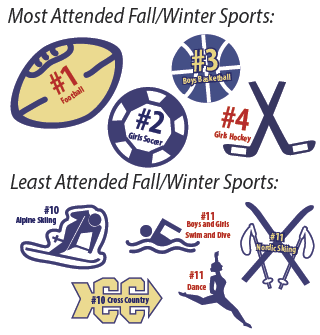Fill the stands and cheer (louder!): build school spirit
Editorial Cartoon: Boraan Abdulkarim
ARE YOU ATTENDING A GAME TONIGHT? Now’s the time to fill the stands with student support.
February 14, 2016
Adrenaline runs through his body as he cuts through the water, limbs straining to reach just a little bit farther, just a few more yards. The athlete emerges from the water and turns toward the stands, with red cheeks and a wide smile – to silence, a smattering of applause. To athletes who participate in sports that are often overlooked or even blatantly ignored by the majority of the student body, including dance, lacrosse, alpine and nordic skiing, swimming, girls hockey, and more, support at sporting events from the school community — be it from their friends, classmates, teachers, or even casual acquaintances — feels crucial because low or no attendance indirectly sends the message to athletes that the student body doesn’t see the sport they invest in as worth the time.
Attending sporting events teaches fans something new about their peers, provides an energizing (and free) social time with friends, and supports all athletic teams.

In the four years of Upper School, annual events like retreats and Service Day dedicate time to fixing problems and building a sense of community. Sophomores and freshmen attend orientation, and juniors even have an entire retreat dedicated to strengthening bonds within their grade. Although these prescribed activities often help students become closer, sports events are an instant and natural way to bond over a game point or a bad call. School sports start the process of building a school community much more naturally than deliberate trust exercises. A recent poll sent out by The Rubicon on student attendance to sporting events revealed that even for boys basketball, which was the sport that’s games were attended most frequently, had a higher percentage of people who never attended a game compared to those who always, frequently, occasionally, or sometimes attended one. This trend was reflected for every winter and fall sport offered at SPA.
It’s easy to see each other as one thing — smart, funny, artsy — in a community this small. But the group identity of the Dance Team or the singular focus of the fencers is often completely different from the class sitting around the Harkness table or a student in the science lab. The new perspective gained from seeing a classmate benefits both the athlete and her classmates; the athlete gets to alter some of the assumptions her classmates, and maybe even teachers, have made about her and the classmate gets to form stronger connections with the athlete and her sport as part of the school community.
Since SPA offers free admission to nearly all games, it’s a perfect opportunity to plan social time with friends. Instead of heading to a restaurant or to the movies for the hundredth time, bring hot chocolate and some warm winter clothes to the next Alpine or Nordic ski meet. Don a t-shirt in February and warm up at a Boys Swim and Dive meet. Cheer with friends, support them, and make a new fan-friend when bonding over a frustrating call or cheering when the team scores.
Supporting friends and classmates in this way and being part of the experience can be especially important for seniors who want to say goodbye to SPA, or freshmen who want to get to know the school better. Ultimately, the appeal of high school sporting events isn’t in the stats — it’s not about seeing whether SPA’s team won or lost — it’s for the experience, the adrenaline, and understanding of how the game is played.
Building a community where team members from every sport feel like they have the might of the SPA student body behind them is as simple as every student choosing to attend one sporting event they haven’t attended before. Then next time, when the swimmer reaches the end of the pool, gasping for air, he would be greeted by the applause of friends and classmates, the stands overflowing with familiar blue and gold.